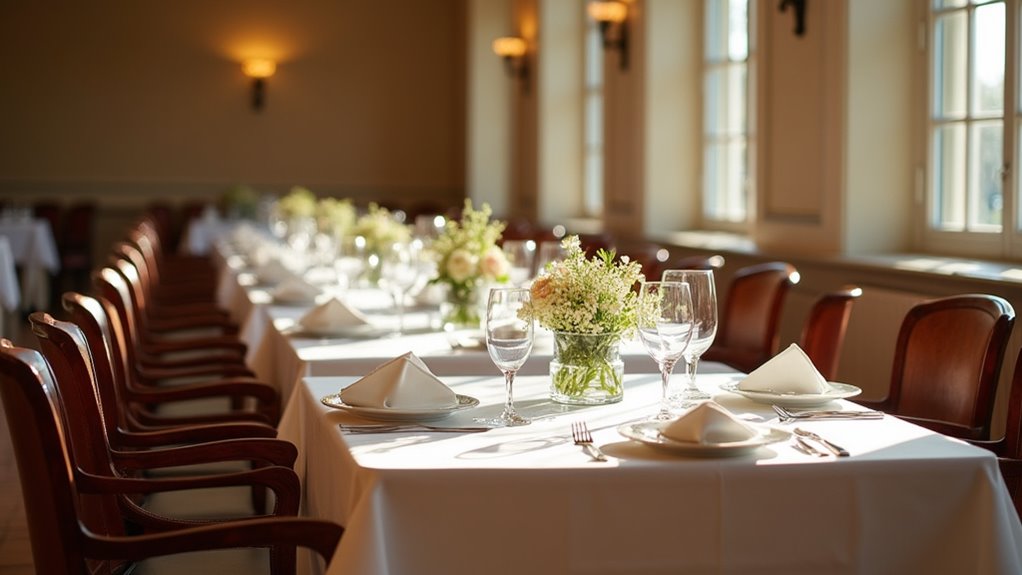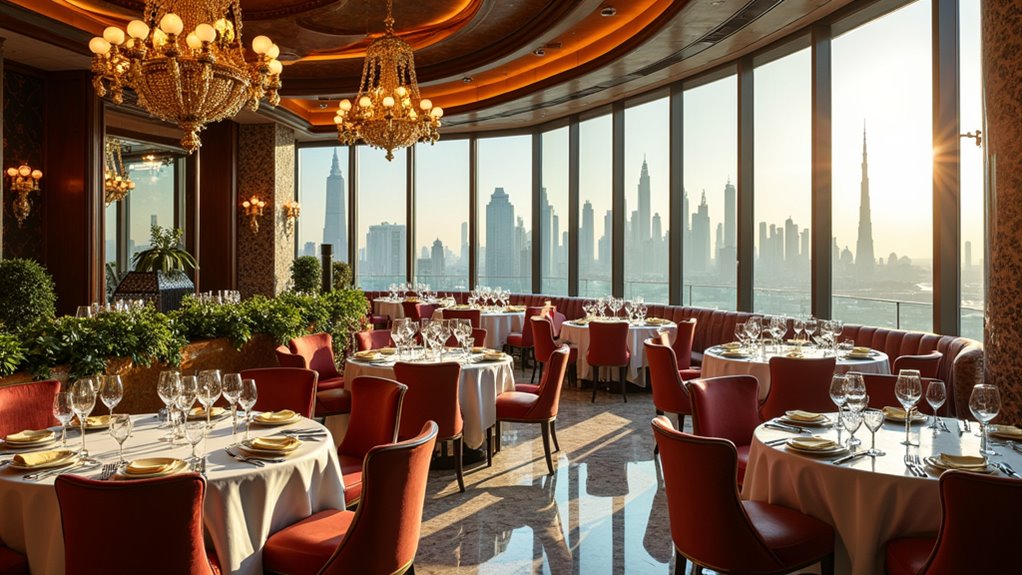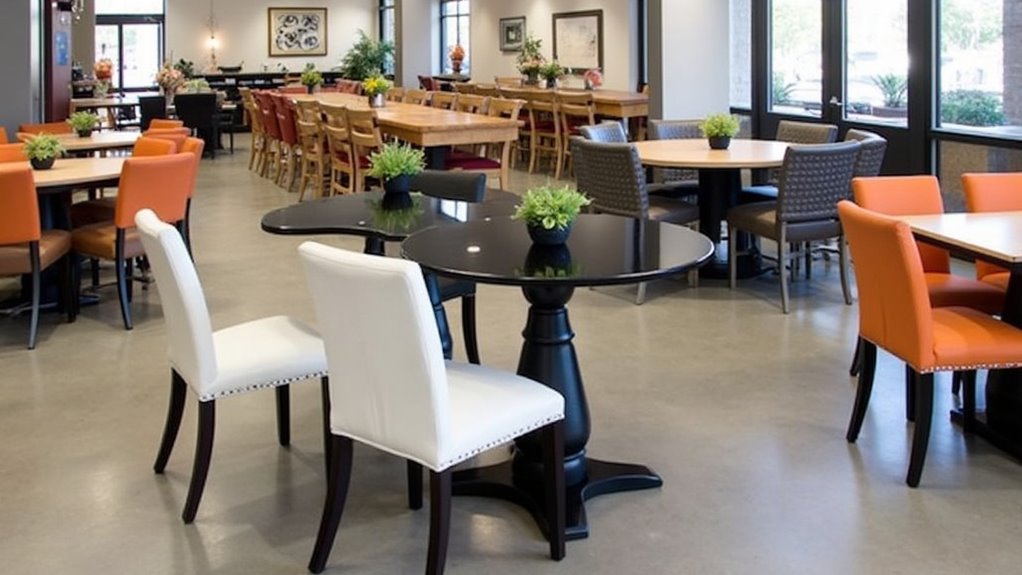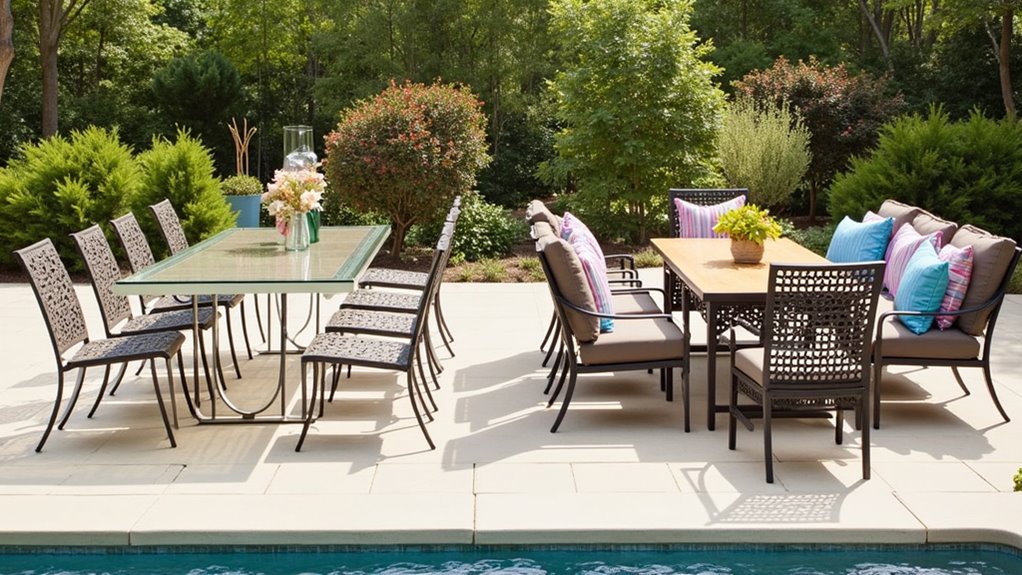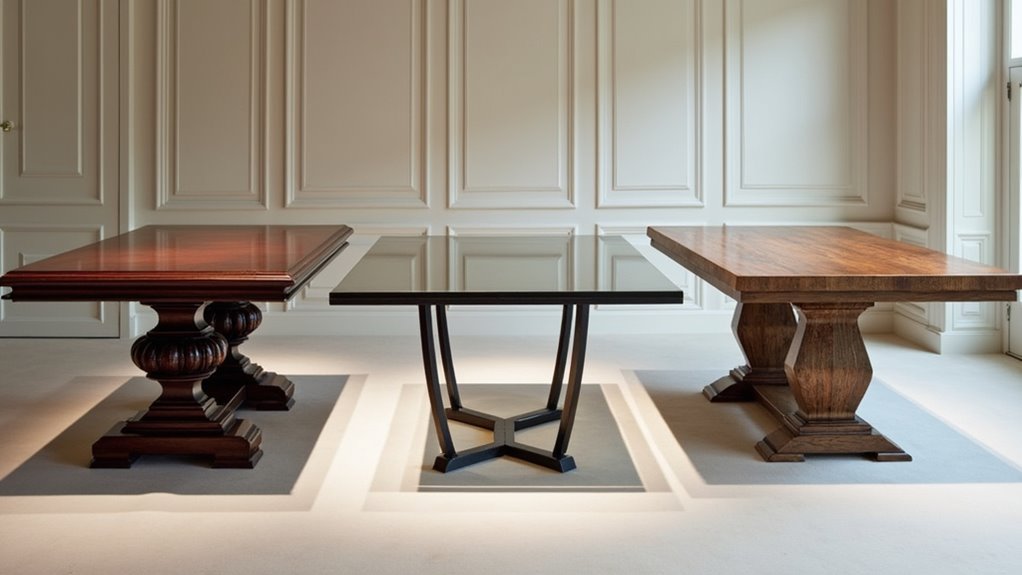Setting up tables in the dining area involves a series of deliberate steps. First, prepare the space by selecting furniture that complements the room’s style and size. Choose appropriate table linens, then arrange cutlery and position plates with care. Glassware should align neatly, and a centerpiece adds visual interest. Finalize table alignment for harmony and verify guest comfort through thoughtful seating arrangements. Maintaining cleanliness is essential for longevity. For more tips on enhancing your dining experience, explore further.
Key Takeaways
- Prepare the dining area with suitable furniture, ensuring style, comfort, and durability to enhance the dining experience.
- Choose appropriate table linens that match your decor while considering ease of maintenance for practicality.
- Arrange plates, cutlery, and glassware neatly to follow dining etiquette and facilitate intuitive use for guests.
- Select and balance centerpieces to add aesthetic appeal without obstructing sightlines or guest interactions.
- Finalize table alignment and verify guest comfort by ensuring sufficient space for movement and seating arrangements.
Prepare the Dining Area
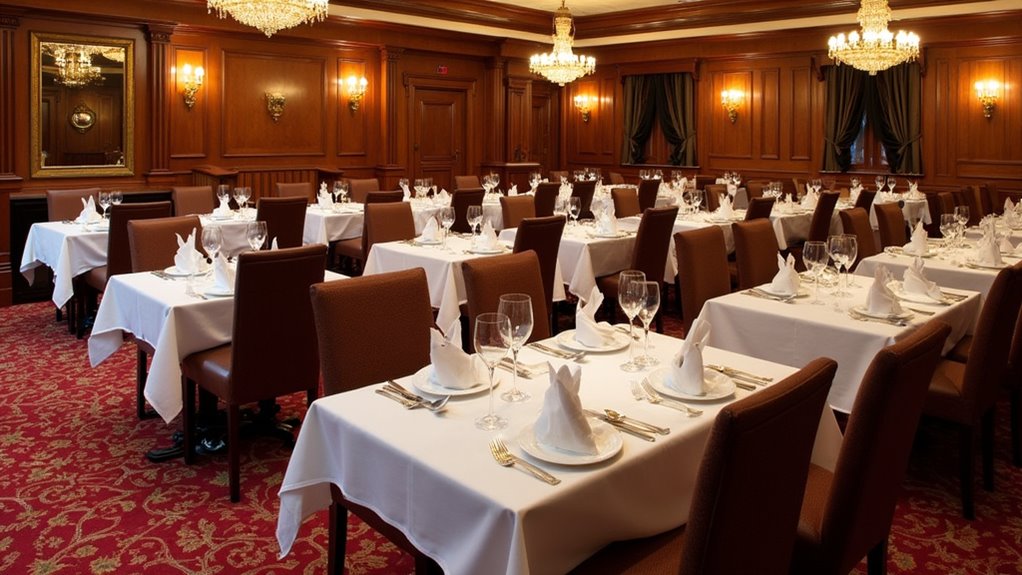
Preparing the dining area requires careful consideration of several key elements to create an inviting and functional space.
Selecting appropriate dining furniture is fundamental; the table’s size must accommodate both the room’s dimensions and guest capacity. The shape of the table—whether rectangular, round, square, or oval—should enhance the dining area style while catering to the specific functions desired. Durability is vital, with materials like wood, glass, or metal offering both aesthetic appeal and long-lasting performance. Table materials are essential to ensuring quality and longevity in your dining setup. A well-chosen table can serve as a centerpiece, drawing attention and adding a stylish focal point to the dining experience. Brand consistency is achieved by ensuring that the chosen table style reflects the restaurant’s identity and theme. Comfort must also be prioritized in chair selection, ensuring they complement the table while optimizing space.
Finally, arranging additional furniture, such as sideboards or consoles, can enhance practicality, providing useful storage and serving options while maintaining a cohesive overall design.
Choose Table Linens
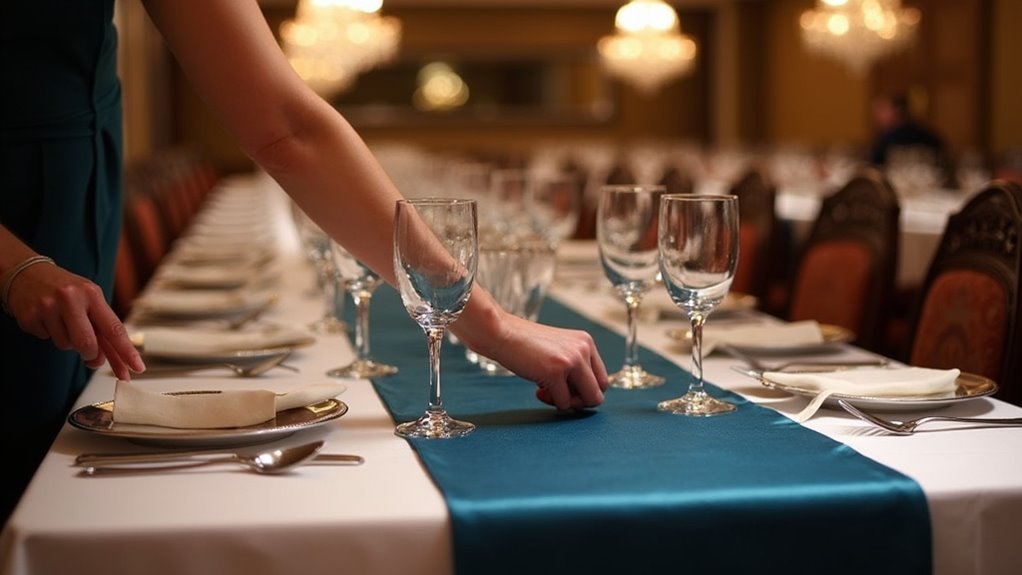
After setting the dining area with appropriate furniture, attention turns to the details that enhance the overall experience—the choice of table linens.
The selection of table linen materials significantly influences both aesthetics and functionality. PU leather offers a sleek, stain-resistant option for modern settings, while cotton provides a cozy, inviting atmosphere but requires regular ironing.
Table linen material choices greatly impact the dining experience, balancing style with practical needs for maintenance and atmosphere.
Linen brings luxury to formal occasions but necessitates delicate care. Polyester stands out for its durability and easy maintenance, making it ideal for families. For high-traffic areas, commercial-grade cotton-polyester blends combine softness with resilience.
Maintenance tips vary: PU leather is low maintenance, while cotton and linen necessitate more care to prevent damage, ensuring that chosen linens maintain their appeal and longevity.
Position Plates and Chargers

In preparing the dining area, careful attention must be given to the placement of charger plates and the subsequent layering of dinnerware.
Chargers should be positioned equidistantly from the table’s edge to ensure a harmonious arrangement that aligns with each guest’s seat.
Proper layering of the dinnerware on the chargers not only enhances aesthetic appeal but also adheres to dining etiquette, establishing a refined and organized table setting. Incorporating antique country dining tables can further elevate the overall ambiance of your dining experience.
Charger Plate Placement
Proper charger plate placement is crucial for creating an inviting and functional dining experience. Chargers should be positioned 1 to 2 inches from the table’s edge, directly aligned with each guest’s chair for both aesthetics and accessibility. This ensures a balanced appearance and maintains at least one inch of clearance from the table edge, preventing any overhang.
When setting chargers, they must rest evenly on tablecloths or placemats, enhancing stability. Charger aesthetics and materials influence the overall table design; therefore, selecting appropriate colors and weights enhances both visual appeal and functionality.
Spacing should be approximately 24 inches center-to-center, providing guests ample elbow room while ensuring a cohesive visual flow that elevates the dining atmosphere.
Layering Dinnerware Properly
Charger plates set the stage for a thoughtfully arranged table, making way for the careful layering of dinnerware that follows.
The dinner plate serves as the base, centered approximately one inch from the table’s edge for optimum ergonomics and aesthetic balance. Next, salad or appetizer plates are positioned centrally atop the dinner plate, ensuring plate stability.
If serving soup, bowls are placed upon or slightly centered on the dinner plate, maintaining a visually appealing texture contrast. Bread-and-butter plates find their place to the upper left of the main plate, streamlining the setting while avoiding crowding.
Consistency in alignment across all settings enhances guest experience, creating a harmonious arrangement that invites engagement and ease of dining.
Arrange Cutlery
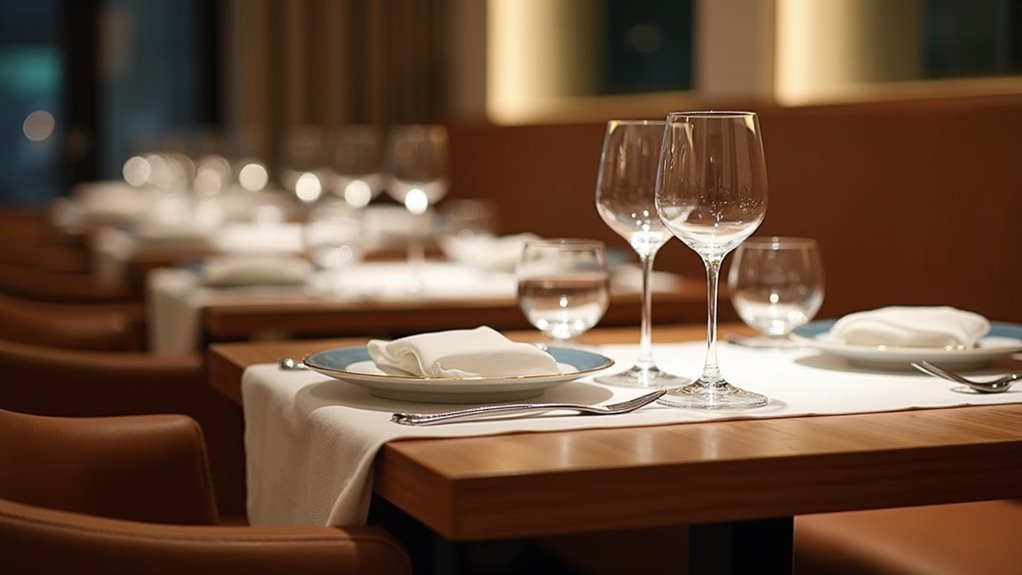
Arranging cutlery is a crucial aspect of creating an inviting dining experience, as it sets the tone for the meal that follows. Forks are traditionally placed to the left, with the dinner fork closest to the plate, while knives and spoons occupy the right side, ensuring adherence to cutlery etiquette.
The arrangement reflects utensil types according to the course order, starting with outermost utensils. For example, a salad fork is positioned left of the dinner fork, and a soup spoon is set right of the knife.
Dessert cutlery is wisely placed above the plate, avoiding unnecessary clutter. Such thoughtful placement enables guests to intuitively select the correct utensil, enhancing both ease and elegance during the dining experience.
Set Glassware
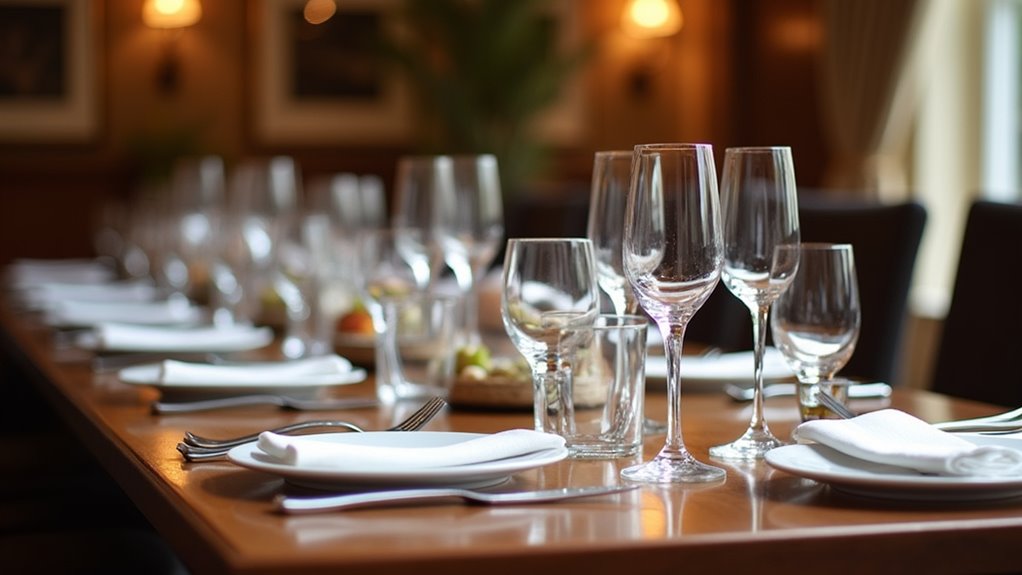
Creating an aesthetically pleasing dining environment involves careful attention to both cutlery and glassware arrangement. Proper glassware placement ensures functionality and elegance. The following table summarizes essential glassware types and their arrangement for formal settings:
| Glassware Type | Placement Guidelines |
|---|---|
| Water Goblet | Above the knife, forming the base for others |
| White Wine Glass | Above or slightly right of the water goblet |
| Red Wine Glass | Right and below or beside the white wine glass |
For a formal meal, all glasses should maintain a neat alignment, respecting size hierarchy. Water goblets serve to cleanse the palate, while wine glasses should be filled appropriately. Consistency in glass type enhances the table’s visual appeal.
Add Napkins and Other Elements

An exceptional dining experience is enhanced by the thoughtful addition of napkins and other elements, which play a crucial role in both functionality and aesthetic appeal.
Napkins should be placed to the left of the plate, ensuring practicality for right-handed diners. Cloth napkins, preferred for formal settings, may feature elegant designs and must be folded meticulously, while paper napkins provide a casual alternative.
Placing napkins to the left of the plate enhances practicality for right-handed diners, with cloth napkins adding elegance to formal occasions.
Napkin presentation is vital; guests should unfold their napkins onto their laps at the meal’s start. Additionally, napkin rings can elevate style while ensuring coordination with table elements.
Clean, well-presented napkins contribute significantly to the overall ambiance, reflecting the event’s formality and enhancing the guest experience.
Include a Centerpiece
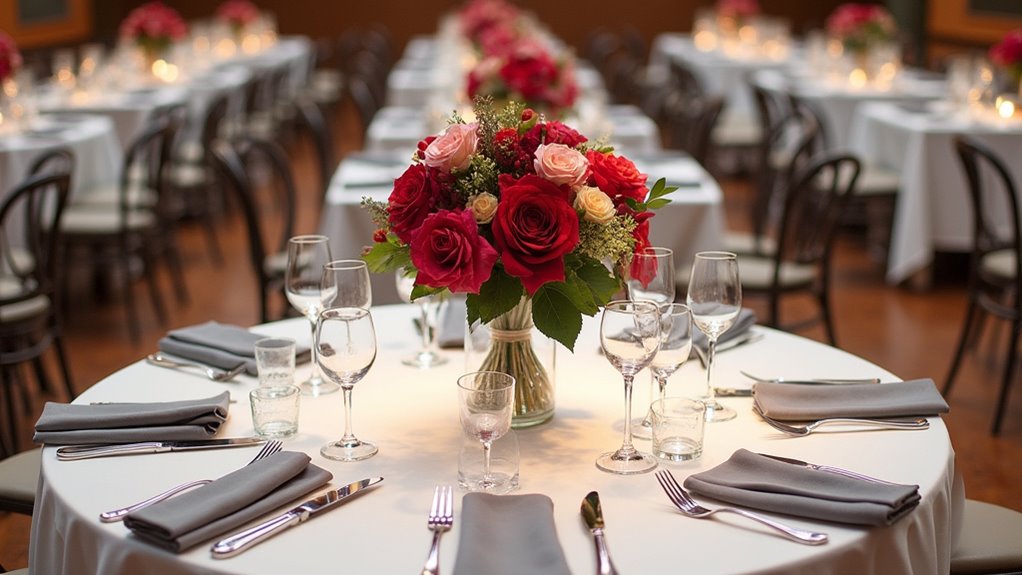
Incorporating a centerpiece into the dining layout serves as both a visual focal point and a functional element.
Selecting the right centerpiece requires careful consideration of aesthetics and practicality to ensure it complements the overall table setting while enhancing the dining experience.
Balancing design with function will create an inviting atmosphere that encourages conversation and enjoyment during meals.
Selecting the Right Centerpiece
How does one select the perfect centerpiece for a dining table?
The choice begins with floral considerations, where fresh or artificial arrangements introduce vibrancy and color. Seasonal themes play a crucial role; spring calls for bright blooms, while fall favors earthy tones with dried elements.
For a modern touch, sculptural vases can serve as minimalist focal points, and incorporating natural elements like wood bowls adds organic texture.
When selecting size and scale, ensure the centerpiece maintains sightlines and complements the table’s dimensions.
Versatile arrangements, such as succulent gardens, can provide low-maintenance beauty.
For added ambiance, candle arrangements can enhance the dining experience while contributing to the overall decor, making it essential to create a harmonious balance across the table setting.
Balancing Design and Function
What elements contribute to a well-balanced dining experience? Achieving balanced aesthetics alongside a functional layout requires strategic space planning and ergonomic considerations.
Ensuring at least 18 inches of clearance between table edges and surrounding structures allows for comfortable chair movement. Select table shapes that harmonize with room dimensions—round tables nurture intimacy, while rectangular tables add versatility.
A thoughtfully chosen centerpiece enhances the table’s visual appeal without obstructing sightlines; it should match the table’s size and height for optimal engagement. Incorporating functional elements, such as extension leaves, can adapt to varying guest numbers.
Finalize Table Alignment
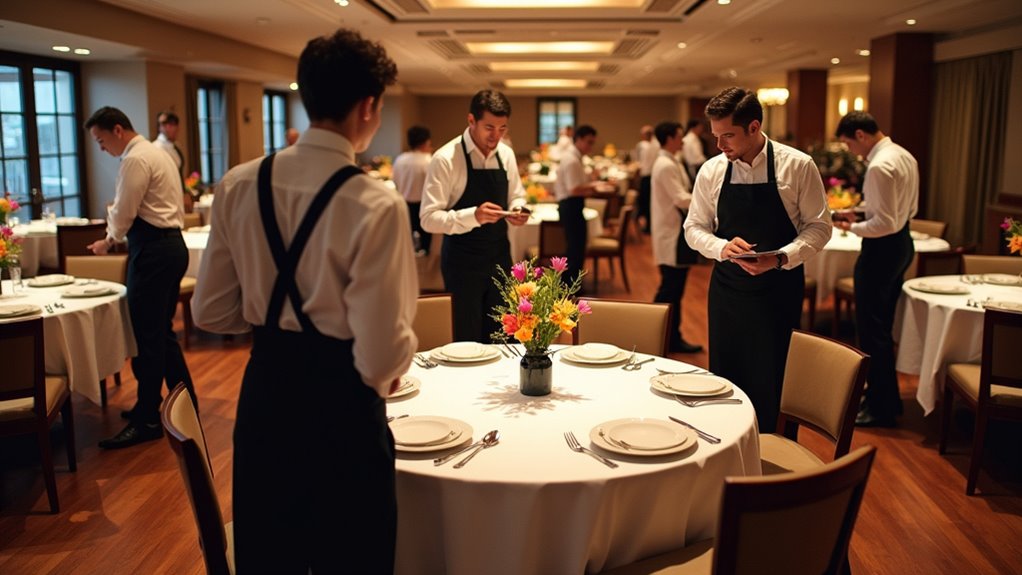
Finalizing table alignment involves a careful assessment of the dining area’s layout and the specific characteristics of the tables in use.
Optimal table layout enhances visual harmony, particularly when aligning rectangular tables parallel to the longest wall. Maintaining consistent orientation between table shape and room shape prevents visual disruption.
Aligning rectangular tables parallel to the longest wall fosters visual harmony and prevents disruption in the dining space.
It is crucial to adjust alignment for natural light and ensure that tables do not obstruct traffic paths or doorways. Adequate clearance—at least 24 inches—on all sides is essential for movement and comfort.
Symmetry enhances aesthetics; centering tables in relation to other furniture creates a focal point. Lastly, modifying placements to accommodate the table’s shape and expected usage is key to achieving a harmonious and functional dining space. Additionally, consider trends in dining tables for 2022, such as extendable tables that provide versatile seating options for guests.
Verify Guest Comfort
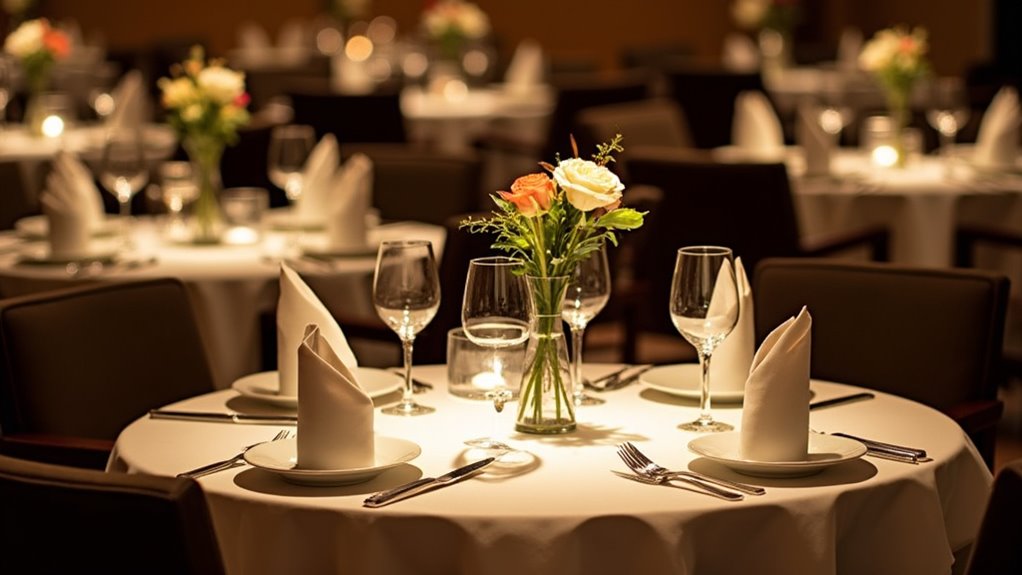
Ensuring guest comfort during dining is pivotal, beginning with a thoughtful seating arrangement tailored to the style of dining.
Adequate space between guests is essential to foster an inviting atmosphere, while adjustable lighting can enhance the overall dining experience by accommodating personal preference and ambiance.
Proper Seating Arrangement
When arranging seating in the dining area, attention to guest comfort should be paramount, as it significantly enhances the overall dining experience.
Different seating types must be considered, adhering to spacing guidelines of 18 to 30 inches between chairs to promote personal space and comfort.
The chosen table shape should inform the arrangement styles; rectangular tables can accommodate more guests along their length, while round tables require careful calculation of space based on diameter.
Moreover, accommodating guest preferences involves ensuring chair height aligns comfortably with table height, and adjusting for varying seat widths.
This meticulous approach to proper seating arrangement not only fosters ease of movement but also enriches interaction and enjoyment during meals.
Adequate Space Between Guests
Comfort in the dining experience hinges on the thoughtful arrangement of space between guests. Effective guest spacing enhances both comfort and functionality.
A well-planned table arrangement incorporates:
- 24 inches per guest for elbow room, ensuring comfortable dining.
- 36 inches clearance from walls to allow easy movement around the table.
- 30 inches between the dining table and adjacent furniture for unobstructed access.
- Legroom consideration of 30 to 36 inches in table depth to prevent overcrowding.
This careful attention to spacing not only reduces the likelihood of accidental spills but also encourages enjoyable interactions among guests.
Adjustable Lighting Options
A carefully curated selection of adjustable lighting options is vital for enhancing the dining experience and verifying guest comfort. Dimmable LED bulbs allow for seamless transitions between vibrant and soft ambiance, catering to both casual and formal dining.
Elegant mini chandeliers and cluster pendant lights contribute to the dining ambiance while enabling effective brightness control. Linear suspension lights ensure direct illumination with adjustable lengths, optimizing lighting efficiency.
Additionally, arc floor lamps offer flexible, directional lighting, perfect for varied seating arrangements. Careful placement, such as clustered pendant lights or recessed fixtures, prevents glare and promotes comfort.
With a focus on warm light temperatures, these options create an inviting atmosphere, ultimately enhancing guest enjoyment and satisfaction during meals.
Maintain Cleanliness and Readiness
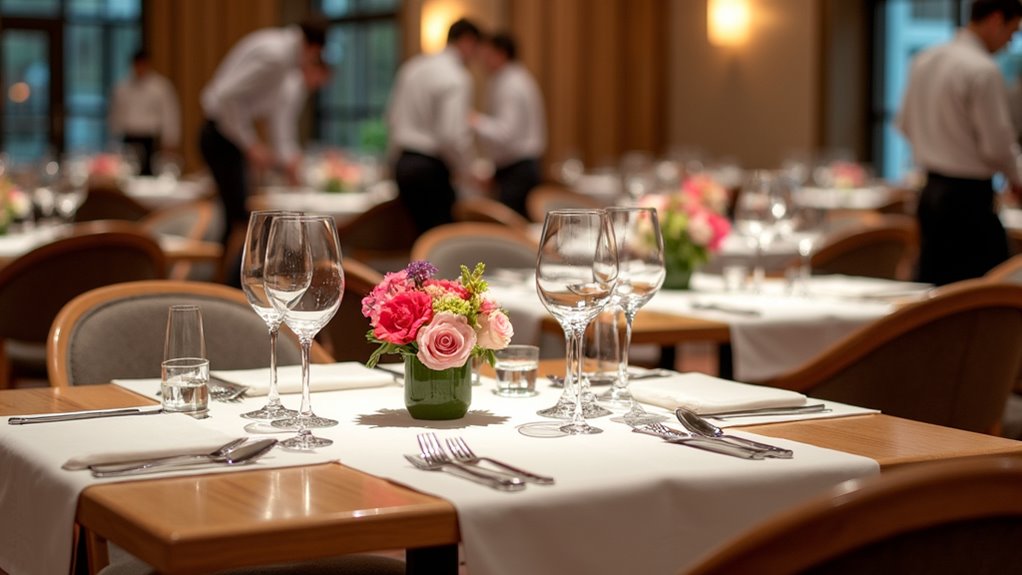
Maintaining cleanliness and readiness in the dining area is essential for creating an inviting atmosphere. Effective management focuses on four key aspects:
- Surface Maintenance: Dust tables weekly with a soft cloth, using mild soap for deeper cleaning to prevent scratches.
- Stain Prevention: Employ protective items such as coasters and placemats to shield surfaces from heat and moisture.
- Spill Response: Clean spills immediately by blotting with a soft cloth to avoid permanent stains or damage.
- Inspection Guidelines: Regularly inspect tables for wear and adjust positioning to minimize damage from environmental factors like sunlight and humidity. This is especially important for solid timber dining tables, as their unique properties can be affected by exposure to elements.
Articles on the same topic:
-
Top 10 Dining Tables in Dubai for All Styles
-
7 Best Commercial Dining Tables and Chairs for Your Business
-
Top 3 Best Selling Dining Tables for 2025
-
Top 3 Brown Jordan Dining Tables for Your Outdoor Area
-
Top 3 Lexington Furniture Dining Tables for Your Home
-
7 Stunning Rustic Log Dining Room Tables for Your Home

